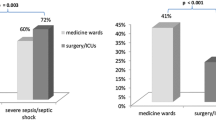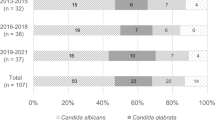Abstract
Our objective was to compare mortality, epidemiology, and morbidity in hospitalized patients with candidemia which was both related and unrelated to the central venous catheter (CVC). This was a monocentric, retrospective cohort study of candidemia. The sample consisted of 103 patients with laboratory-confirmed nosocomial candidemia hospitalized between 2006 and 2013 in a tertiary care public hospital. We included 65 (63.1 %) patients (24 in the CVC-positive group, 41 in the CVC-negative group). Demographic data and risk factors were recorded using a structured case report form. In the group of candidemia associated to the CVC, survival at day 50 was 58.6 ± 11.9 %, compared to 26.5 ± 8.9 % for the CVC-negative group (p-value = 0.012); the hazard ratio of death was 0.38 (95 % confidence interval 0.17–0.85, p-value = 0.019). Compared with the CVC-positive patients, CVC-negative patients were often colonized with yeast (41.5 % vs. 16.7 %, p-value = 0.041), had a shorter previous in-hospital stay (20 days vs. 34 days, p-value = 0.023), and were more severely ill (severe sepsis 85.4 % vs. 58.3 %, p-value = 0.016). In this study, when the origin of candidemia was not the CVC, patients were more seriously ill, had a higher mortality rate, and the removal of the catheter seemed to lead to disappointing results. It would be useful to explore the impact of retention of the CVC on survival in the CVC-negative patients, where the CVCs are essential to treating these patients.


Similar content being viewed by others
References
Vitale RG, Nucci M (2014) Diagnosis of Candidemia. Curr Fungal Infect Rep 8:90–94
Wisplinghoff H, Ebbers J, Geurtz L et al (2014) Nosocomial bloodstream infections due to Candida spp. in the USA: species distribution, clinical features and antifungal susceptibilities. Int J Antimicrob Agents 43:78–81
Colombo AL, Guimarães T, Silva LR et al (2007) Prospective observational study of candidemia in São Paulo, Brazil: incidence rate, epidemiology, and predictors of mortality. Infect Control Hosp Epidemiol 28:570–576
Cuervo G, Puig-Asensio M, Garcia-Vidal C, Fernández-Ruiz M, Pemán J, Nucci M, Aguado JM, Salavert M, González-Romo F, Guinea J, Zaragoza O, Gudiol C, Carratalà J, Almirante B; CANDIPOP Project; Validation Cohort Project (2015) A simple prediction score for estimating the risk of candidaemia caused by fluconazole non-susceptible strains. Clin Microbiol Infect 21:684.e1–684.e9
Puig-Asensio M, Ruiz-Camps I, Fernández-Ruiz M, Aguado JM, Muñoz P, Valerio M, Delgado-Iribarren A, Merino P, Bereciartua E, Fortún J, Cuenca-Estrella M, Almirante B; CANDIPOP Project; GEIH-GEMICOMED SEIMC; REIPI (2015) Epidemiology and outcome of candidaemia in patients with oncological and haematological malignancies: results from a population-based surveillance in Spain. Clin Microbiol Infect 21:491.e1–491.e10
Eggimann P, Garbino J, Pittet D (2003) Epidemiology of Candida species infections in critically ill non-immunosuppressed patients. Lancet Infect Dis 3:685–702
Eggimann P, Que YA, Revelly JP, Pagani JL (2015) Preventing invasive candida infections. Where could we do better? J Hosp Infect 89:302–308
Leroy G, Lambiotte F, Thévenin D et al (2011) Evaluation of “Candida score” in critically ill patients: a prospective, multicenter, observational, cohort study. Ann Intensive Care 1:50
Shah DN, Yau R, Weston J et al (2011) Evaluation of antifungal therapy in patients with candidaemia based on susceptibility testing results: implications for antimicrobial stewardship programmes. J Antimicrob Chemother 66:2146–2151
Garey KW, Rege M, Pai MP et al (2006) Time to initiation of fluconazole therapy impacts mortality in patients with candidemia: a multi-institutional study. Clin Infect Dis 43:25–31
Caeiro JP, Riera F (2014) Candida sepsis: a new entity? Curr Fungal Infect Rep 8:95–101
Glöckner A, Cornely OA (2013) Practical considerations on current guidelines for the management of non-neutropenic adult patients with candidaemia. Mycoses 56:11–20
Centers for Disease Control and Prevention (CDC) (2014) Central line-associated bloodstream infection (CLABSI). Event
Nucci M, Anaissie E (2002) Should vascular catheters be removed from all patients with candidemia? An evidence-based review. Clin Infect Dis 34:591–599
Cornely OA, Bassetti M, Calandra T et al (2012) ESCMID* guideline for the diagnosis and management of Candida diseases 2012: non-neutropenic adult patients. Clin Microbiol Infect 18:19–37
Deshpande A, Gaur S, Bal AM (2013) Candidaemia in the non-neutropenic patient: a critique of the guidelines. Int J Antimicrob Agents 42:294–300
Eggimann P, Pittet D (2006) Candida colonization index in the management of critically ill patients. In: Vincent JL (ed) Yearbook of intensive care and emergency medicine. Springer-Verlag, Berlin Heidelberg, pp 604–612
Leenders NHJ, Oosterheert JJ, Ekkelenkamp MB et al (2011) Candidemic complications in patients with intravascular catheters colonized with Candida species: an indication for preemptive antifungal therapy? Int J Infect Dis 15:e453–e458
Nucci M, Anaissie E, Betts RF et al (2010) Early removal of central venous catheter in patients with candidemia does not improve outcome: analysis of 842 patients from 2 randomized clinical trials. Clin Infect Dis 51:295–303
Clancy CJ, Nguyen MH (2012) The end of an era in defining the optimal treatment of invasive candidiasis. Clin Infect Dis 54:1123–1125
Mermel LA, Allon M, Bouza E et al (2009) Clinical practice guidelines for the diagnosis and management of intravascular catheter-related infection: 2009 Update by the Infectious Diseases Society of America. Clin Infect Dis 49:1–45
Bouza E, Alcalá L, Muñoz P (2013) Can microbiologists help to assess catheter involvement in candidaemic patients before removal? Clin Microbiol Infect 19:E129–E135
Garnacho-Montero J, Díaz-Martín A, García-Cabrera E et al (2013) Impact on hospital mortality of catheter removal and adequate antifungal therapy in Candida spp. bloodstream infections. J Antimicrob Chemother 68:206–213
Pappas PG, Kauffman CA, Andes DR, Clancy CJ, Marr KA, Ostrosky-Zeichner L, Reboli AC, Schuster MG, Vazquez JA, Walsh TJ, Zaoutis TE, Sobel JD (2016) Clinical practice guideline for the management of candidiasis: 2016 Update by the Infectious Diseases Society of America. Clin Infect Dis 62:e1–e50
Blankenship JR, Mitchell AP (2006) How to build a biofilm: a fungal perspective. Curr Opin Microbiol 9:588–594
Cockerill FR 3rd, Wilson JW, Vetter EA et al (2004) Optimal testing parameters for blood cultures. Clin Infect Dis 38:1724–1730
De Rosa FG, Trecarichi EM, Montrucchio C et al (2013) Mortality in patients with early- or late-onset candidaemia. J Antimicrob Chemother 68:927–935
Grim SA, Berger K, Teng C et al (2012) Timing of susceptibility-based antifungal drug administration in patients with Candida bloodstream infection: correlation with outcomes. J Antimicrob Chemother 67:707–714
Jones AE, Puskarich MA (2013) The Surviving Sepsis Campaign guidelines 2012: update for emergency physicians. Ann Emerg Med 63:35–47
Lagrou K, Verhaegen J, Peetermans WE, De Rijdt T, Maertens J, Van Wijngaerden E (2007) Fungemia at a tertiary care hospital: incidence, therapy, and distribution and antifungal susceptibility of causative species. Eur J Clin Microbiol Infect Dis 26:541–547
Rodriguez D, Park BJ, Almirante B et al (2007) Impact of early central venous catheter removal on outcome in patients with candidaemia. Clin Microbiol Infect 13:788–793
Tang HJ, Liu WL, Lin HL et al (2014) Clinical manifestations and prognostic factors of central line-associated candidemia. Am J Infect Control 42:1238–1240
Fortún J, Martín-Dávila P, Gómez-García de la Pedrosa E et al (2012) Emerging trends in candidemia: a higher incidence but a similar outcome. J Infect 65:64–70
Bouza E, Alvarado N, Alcalá L et al (2007) A randomized and prospective study of 3 procedures for the diagnosis of catheter-related bloodstream infection without catheter withdrawal. Clin Infect Dis 44:820–826
Liu CY, Huang LJ, Wang WS et al (2009) Candidemia in cancer patients: impact of early removal of non-tunneled central venous catheters on outcome. J Infect 58:154–160
Raad I, Hanna H, Boktour M et al (2004) Management of central venous catheters in patients with cancer and candidemia. Clin Infect Dis 38:1119–1127
Maki DG, Weise CE, Sarafin HW (1977) A semiquantitative culture method for identifying intravenous-catheter-related infection. N Engl J Med 296:1305–1309
Decool V (2012) Place du dosage des béta-(1,3)-D-glucanes dans le diagnostic des maladies fongiques invasives. Thèse en vue du diplôme d’Etat de Docteur en pharmacie, Université de Lille 2
Guimarães T, Nucci M, Mendonça JS et al (2012) Epidemiology and predictors of a poor outcome in elderly patients with candidemia. Int J Infect Dis 16:e442–e447
Nguyen MH, Peacock JE Jr, Tanner DC et al (1995) Therapeutic approaches in patients with candidemia. Evaluation in a multicenter, prospective, observational study. Arch Intern Med 155:2429–2435
Birch MW (1964) The detection of partial association, I: the 2 × 2 case. J R Stat Soc Ser B 26:313–324
Koopman PAR (1984) Confidence intervals for the ratio of two binomial proportions. Biometrics 40:513–517
Farrar DE, Glauber RR (1967) Multicollinearity in regression analysis: the problem revisited. Rev Econ Stat 49:92–107
Acknowledgments
We thank all those who helped us in this study; in particular, the Infectious Diseases Department and the Microbiology Department for making this study possible.
We thank Mr. Cathal Mac Gabhann for checking the English version of the manuscript.
Author information
Authors and Affiliations
Corresponding author
Ethics declarations
Financial support
No financial support was received for this work.
Conflict of interest
None of the authors report conflicts of interest relevant to this article.
Ethics committee
This work was approved by the ethics committee at Hôpital Brugmann on 15th October 2014.
Rights and permissions
About this article
Cite this article
Arias, S., Denis, O., Montesinos, I. et al. Epidemiology and mortality of candidemia both related and unrelated to the central venous catheter: a retrospective cohort study. Eur J Clin Microbiol Infect Dis 36, 501–507 (2017). https://doi.org/10.1007/s10096-016-2825-3
Received:
Accepted:
Published:
Issue Date:
DOI: https://doi.org/10.1007/s10096-016-2825-3




